Growing a bonsai is exciting, isn’t it? The moment you get deep into the bonsai culture, you start to have this urge to buy whatever bonsai tools you see professionals are using because you believe that having those tools will help kick off your journey.
While that may be true at some point, knowing what specific bonsai gardening equipment you need for your tree is necessary. As doing so will save you lots of money, but more than that, it’ll help you better master the techniques you want to perform.
That being said, if you want to learn about miniature tree cultivation implements and their uses, let me walk you through them!
Read on to discover:
- Several tips and reminders when using specific bonsai gardening equipment.
- The pros and cons of buying cheap vs. expensive bonsai pruning tools.
- Key differences between carbon steel and stainless steel materials.
- 15 essential tools for beginners, advanced, and professional bonsai growers.
- And that’s only the beginning…
Extensive List of Bonsai Pruning Tools
To help you know which ones to buy, here’s an extensive list of essential bonsai pruning tools for every bonsai grower:
4 Essential Bonsai Tools for Beginners
Start with a few tools if you’re growing your first bonsai tree.
Doing so will help you slowly but effectively understand the purpose of each tool. And their effect on your bonsai tree.
1. Wooden chopsticks
Category: Repotting and watering tool
Several uses:
- To act as a moisture meter for the soil
- To remove the old soil from the root ball
- To help the substrates get into the root ball
- To aerate and loosen the bonsai soil mixture
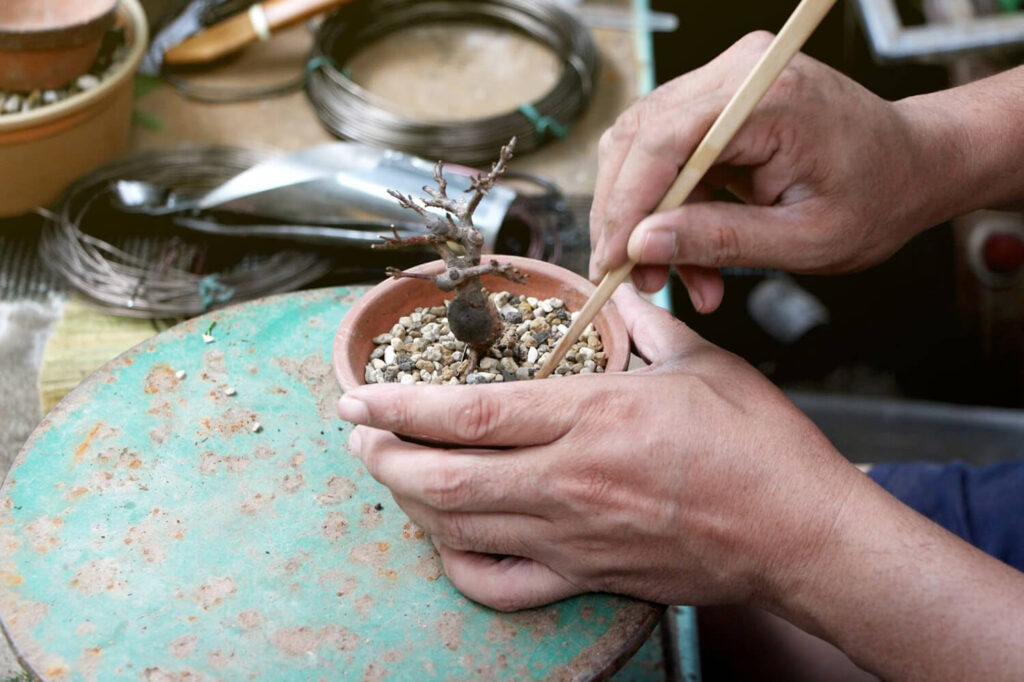
A pair of chopsticks is one of the cheapest and simplest bonsai gardening equipment you can ever have.
Many bonsai growers, even professionals, use this whenever they repot their trees. This is specifically used for removing old soil and helping substrates penetrate the root ball once repotted.
While you can use a metal chopstick, a wooden one would be better. That’s because you can also use a wooden chopstick as a moisture meter for your bonsai soil.
How to use a chopstick for removing old soil:
- Stick the chopstick parallel to the underside of the root ball.
- Push it downwards to comb the roots and remove the oil soil.
- Once the underside is flat, do the same technique to the periphery of the root ball.
- Then, poke the root ball to loosen and aerate it.
How to use a chopstick as a moisture meter:
- Stick a chopstick upright into the soil. Make sure that the tip touches the bottom of the pot. Then, leave it as is.
- Lift the chopstick several times a day, especially during the summer.
- If the lower part of the chopstick is dry, take it as a sign to water your tree.
Alternative tools to use: Root hook or rake for removing old soil (see below).
2. Bonsai shears
Category: Cutting and styling tool
Several uses:
- To prune roots
- To cut branches
- To remove unwanted growths
- To trim leaves, buds, or needle pines
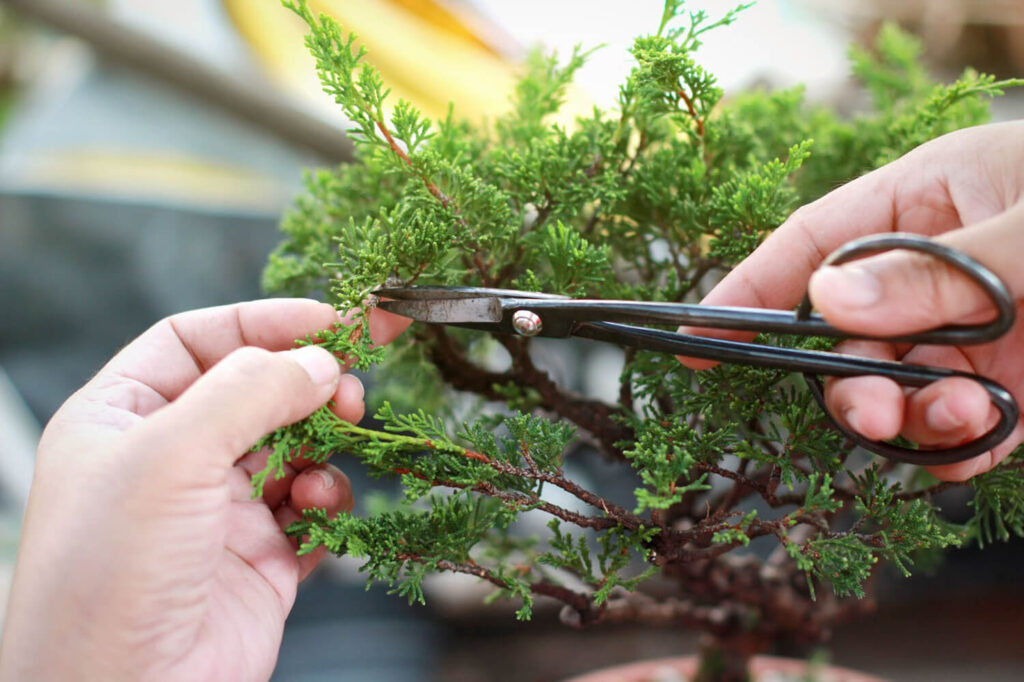
While having one good standard pair of shears is enough to start, having the right type of shears for different specific uses is super helpful.
That said, here are several different types of shears you can get depending on your need:
- Standard garden shears: used for pruning roots.
- Twig & bud shears: used for trimming twigs and buds.
- Pruning shears: used for pruning or removing branches.
- Leafcutter: used for removing leaves or long shoots and thinning foliage.
- Shohin & Azalea shears: used for smaller bonsai trees and Azalea species.
Make sure not to use specific shears other than their intended purposes to avoid damaging the bonsai pruning tools.
Tips & reminders:
- Sharpen your shears if needed for easier pruning.
- Choose a size of shears that matches the size of your tree.
- Wash and dry carbon steel shears right after use to avoid rust.
- Avoid bumping the blades of your shears on hard surfaces to avoid dulling.
3. Concave branch cutter
Category: Cutting tool
Some uses:
- To create a concave wound
- To cut branches that are large
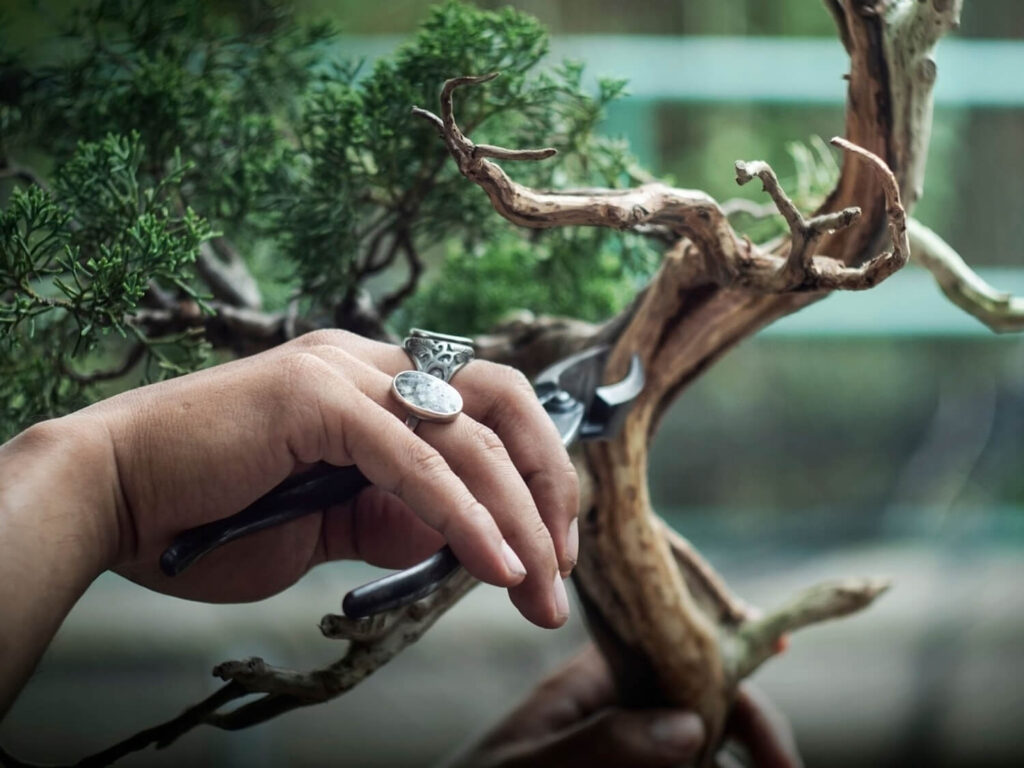
It’s a type of cutter that leaves a concave wound to the cut area.
A concave wound helps promote smoother callous healing, which makes trees appear neater and more natural-looking. Pair that with a cut paste, then you’d have a cut wound with little to no scar.
Note: Sometimes you’d have to use a grafting knife or a knob cutter as well to flatten or clean up the wound.
You can buy concave branch cutters in varying sizes. Make sure to get one that’s appropriate to your tree branches’ thickness.
Tips & reminders:
- Use the blade’s rear part than its edges to avoid cracks.
- Use a trunk splitter to “soften” stronger branches before clipping.
- If the branch is too thick or hard, cut it partially using the concave cutter until the whole branch is removed.
Alternative tools to use: Knob cutter for short branches (see below).
4. Bonsai wire cutter
Category: Cutting tool
Main uses:
- To cut wires when wiring branches
- To cut wires when securing the tree into the pot during repotting
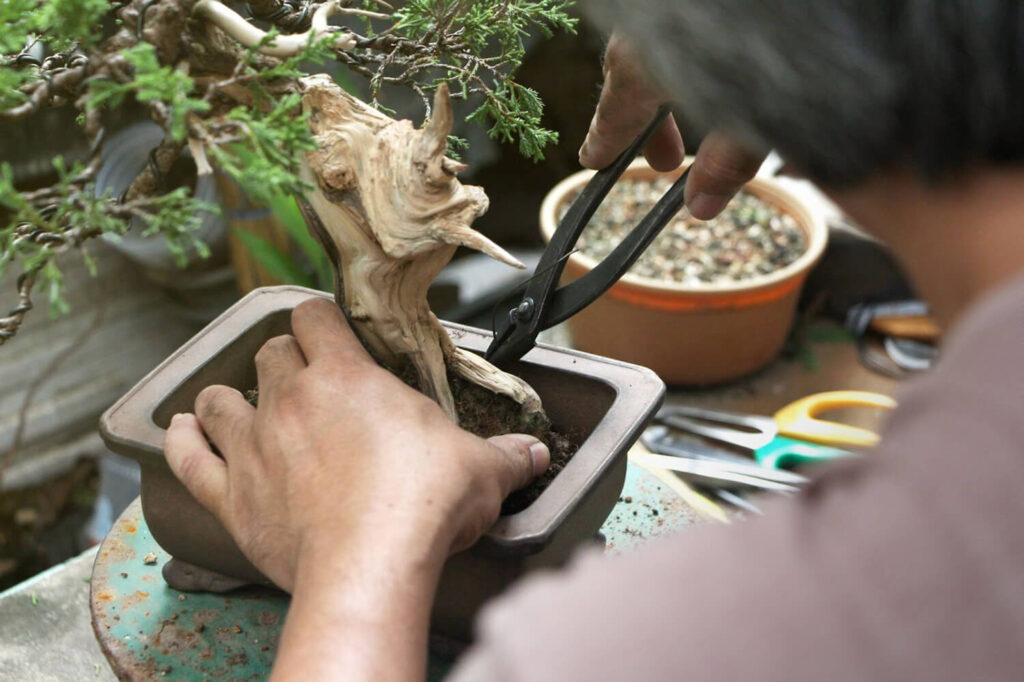
Regardless if your tree is young or mature, you’d need to wire your tree at some point. That said, you’d need to have a handy bonsai wire cutter with you.
“Can’t I just use regular pliers? Or perhaps one of my sharp shears?”
The issue with regular hardware pliers is that it has a larger head, which can sometimes block you from accessing harder-to-reach areas of your tree. Additionally, it often leaves marks on the branch when cutting excess wire.
In the case of pruning shears, it most likely won’t cut a thicker wire and also cause the blades to become blunt.
With a bonsai wire cutter, you’d have no problem snipping wire as it has a slimmer head and longer handles. You can get a scissor-type bonsai wire cutter for convenient and comfortable use or a heavy-duty one for cutting thicker wires with ease.
Tips & reminders:
- Avoid using your bonsai wire cutters for other purposes to avoid dulling.
- If you can only have one, choose a heavy-duty wire cutter as this can cut any gauges of wire.
Alternative tool to use: Regular hardware pliers. (But use them with more caution, especially when cutting wires that are already attached to the branches).
10 Specialty Bonsai Tools for Advanced Bonsai Growers
Once you’re ready to perform a little trickier and more advanced techniques, you can start investing in specialty tools for jin or shari making, heavy branch bending, and more.
Here are the necessary bonsai pruning tools you’d need for that:
1. Knob cutter
Category: Cutting tool
Some uses:
- To cut tree branches that are short
- To clean up a wound, initially cut using a concave cutter
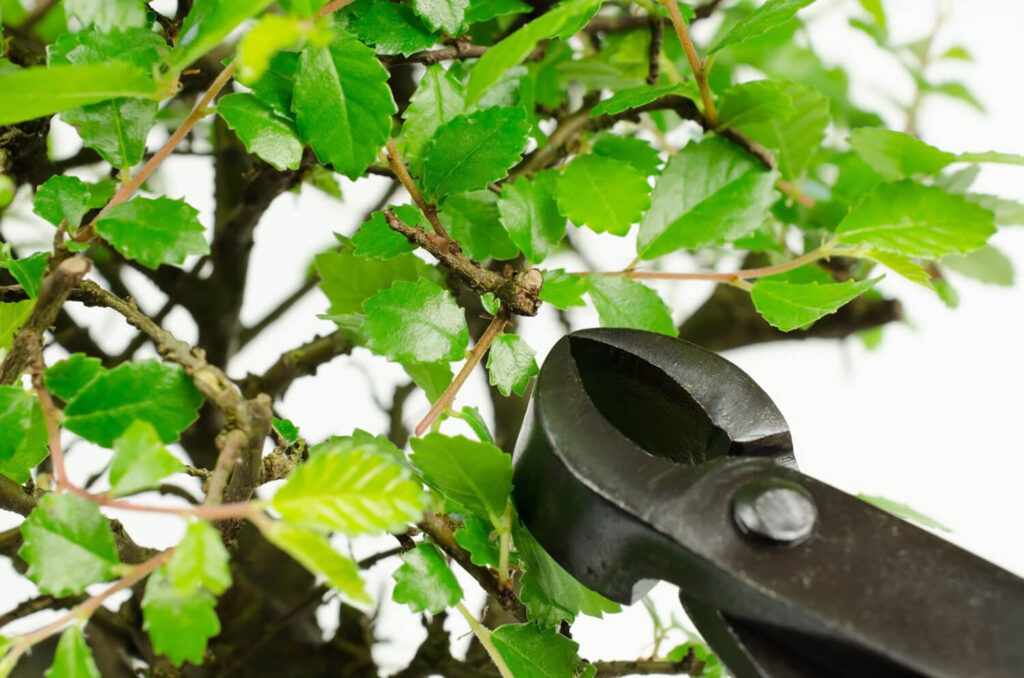
Knob cutters have a similar use to concave branch cutters. The only difference is that the former creates a much deeper wound that looks more realistic and natural.
However, since it has rounded blades, the risk of removing more wood than needed is higher, so you’d have to be very careful when using it.
If you’re planning to buy one, get a knob cutter with slightly overlapping blades as these types are less likely to break.
How to use a knob cutter to clean up a wound:
- Suppose the wound is small enough to fit between the tips of a knob cutter. Position it parallel to the wound, then cut it once or more as necessary.
- Suppose the wound is too large to fit. Start by clipping one side of the wound. Then, continue clipping the rest of it until the whole wound surface smoothens.
Did you know there’s a tool designed to function both as a concave branch cutter and a knob cutter? What this video to find out more about it:
2. Jin splitter or jin pliers
Category: Cutting and styling tool
Several uses:
- To create a jin
- To help in creating a shari
- To secure or tighten guy wires during repotting
So, you want to create a jin on your bonsai tree? Then, grab a jin splitter or pliers.
Since it doesn’t necessarily need to be “sharp” to work, you can freely and safely use it for other purposes. That includes helping create a shari on juniper trees, or even in tightening guy wires when doing a repot or anchor wiring.
How to use a jin splitter to create a jin:
- Position the jin pliers on a small or cut branch that you want to create as jin.
- Then, press the branch using it to loosen and remove the bark.
Alternative bonsai tools to use: Regular hardware pliers or trunk splitter but only to loosen the bark.
3. Carving tools
Category: Styling tool
Some uses:
- To assist in creating or enhancing a shari or jin
- To clean up a wound created by a concave cutter or pruning saw
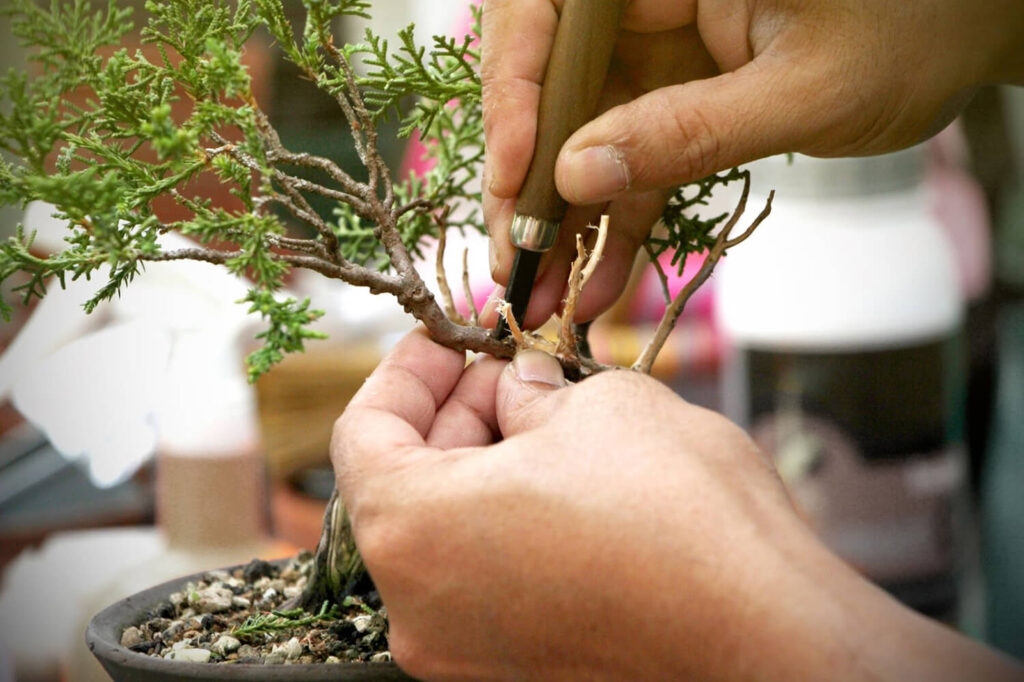
Creating a jin or shari helps add more drama, story, and visual age to the tree. If you want to create one on your tree, you’d need at least one carving tool like a grafting knife.
You can also use different types of chisels or gouges, such as the following:
- Fishtail or double-edged gouge: for outlining shari or jin.
- V-shape, curved, loop, or spoon gouge: for peeling off bark.
How to use carving tools, such as a grafting knife, to create a shari:
- Use a fishtail or double-edged gouge to outline your bonsai shari.
- Remove loose and large bark using pliers.
- Grab a V-shape, curved, loop, or spoon gouge chisel.
- Then, drag it downwards to scrape off the remaining fibers and expose the deadwood.
Alternative tool to use: Rotary tool but only for creating shari (see below).
4. Gas torch
Category: Styling tool
Main use:
- To burn off fibers left on a jin or shari

To make your bonsai jin or shari appear “natural,” it should be free of any blemish. This includes strands of fibers left from peeling off the bark.
You can use a regular pair of tweezers to remove each piece of fiber but that would take so much time. Instead, use a gas torch or burner to burn off the fibers quickly and easily.
Don’t worry, exposing your tree to fire for a quick second won’t hurt it!
Tips & reminders:
- Use protective gloves to protect yourself from harm.
- Use the torch very quickly to avoid leaving burnt marks on your tree.
Alternative bonsai tools to use: Any similar handy fire or lighting equipment.
5. Pruning saw
Category: Cutting tool
Some uses:
- To collect yamadori
- To remove thick branches
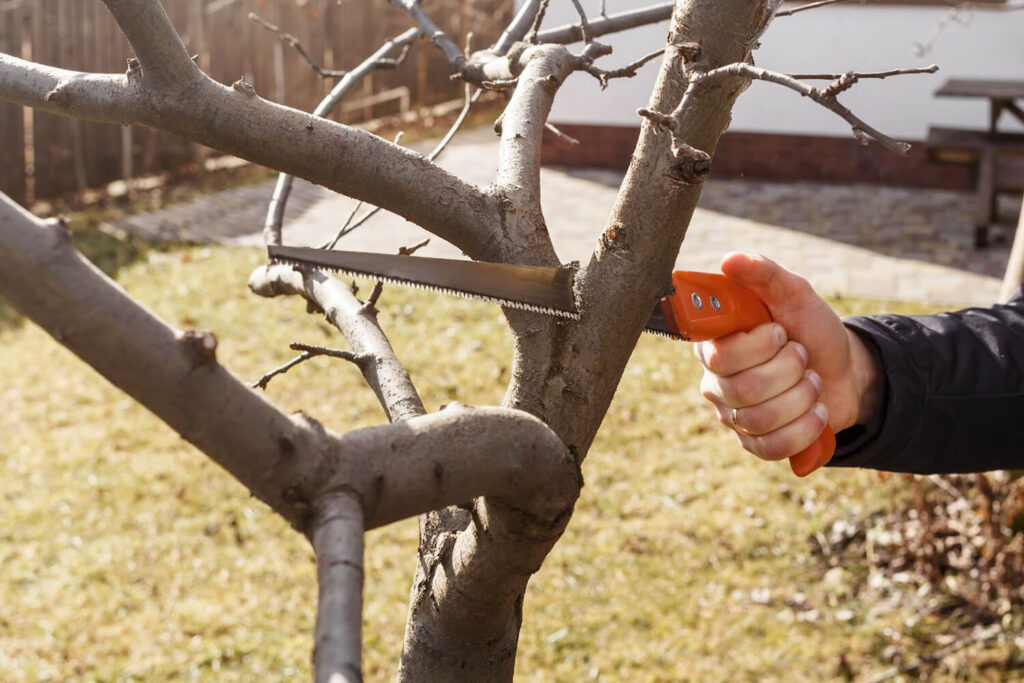
A pruning saw works the same as a regular hand saw. You move the saw forward and backward to cut off the wood.
The only difference with a pruning saw is that it has finer toothing and a slimmer body that can reach and cut inner branches just fine.
You should use it lightly and only by pulling it, otherwise, the blades will break.
How to use a pruning saw to remove a branch:
- Position the pruning saw on top of the branch you want to remove.
- Pull it towards you several times to cut the branch.
Alternative tool to use: Mini hardware hand saw.
6. Trunk splitter
Category: Styling tool
Some uses:
- To soften or loosen the bark around the branch
- To prepare branches or trunks for heavy bending
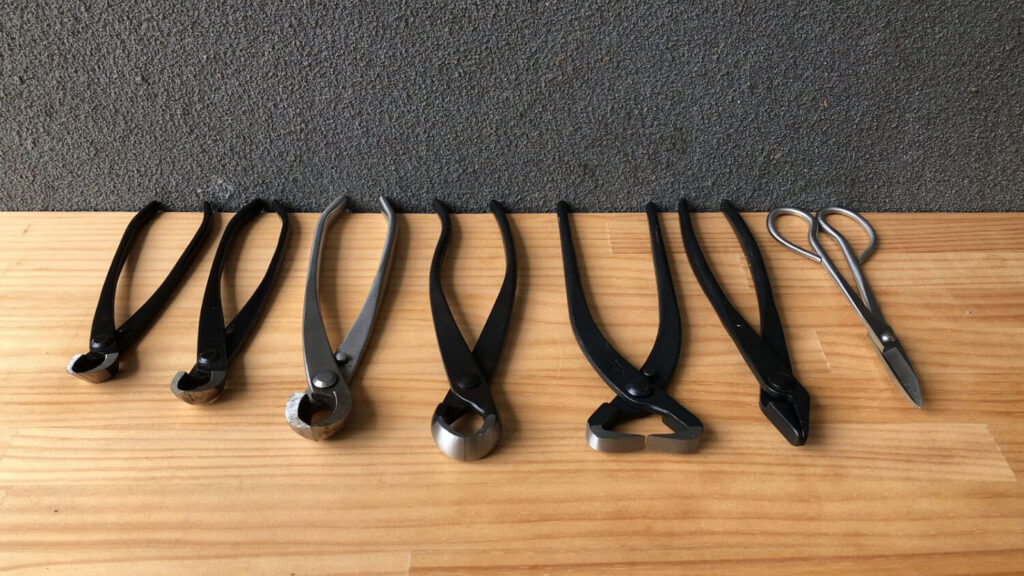
(The trunk splitter is the 3rd item from the right.)
Doing anchor wiring is one way you can do heavy bending. Some tree branches or trunks are too stiff for it. Some are too brittle to withstand too much pressure.
To soften and avoid it from breaking, use a trunk splitter. This tool partially splits trunks or branches, which makes them somewhat flexible for heavy bending.
If you’re wondering whether it hurts or kills a tree, no, it doesn’t. The sap travels vertically, so, doing so doesn’t disturb or affect the system of the tree. However, you must take extreme caution when using this as it can completely break off branches or trunks when used incorrectly.
How to use a trunk splitter to help bend a branch:
- Cut the area vertically or parallel to it.
- Beginning from the lower or rear part, create straight-cut lines as much as possible.
- Then, test-bend the targeted part and see if more cuts are needed.
7. Branch jack
Category: Styling tool
Main use:
- To support and keep a bent branch in position
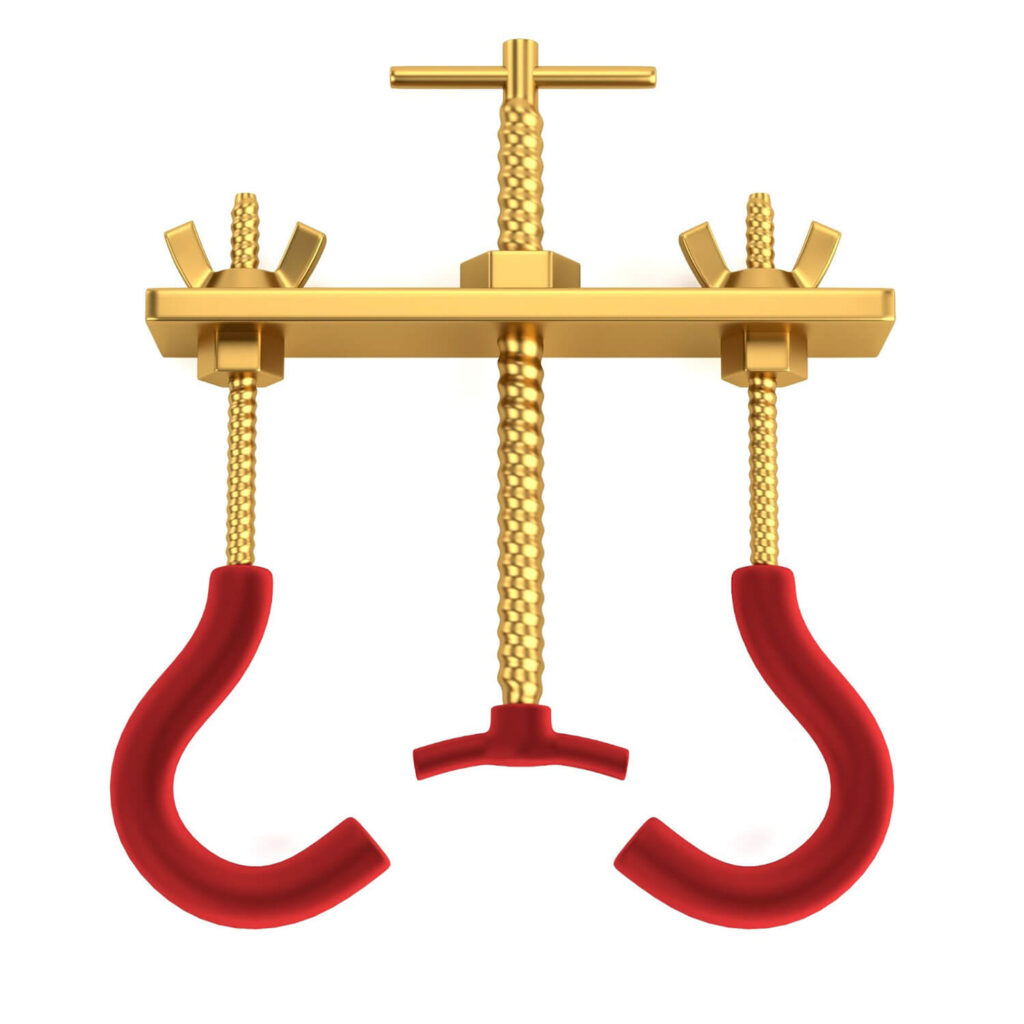
Branch jack or branch bender…
Whatever you call it, this tool is used for one thing, and that is to keep bent branches or trunks in a certain position as long as needed.
When used incorrectly, a branch jack can damage or break your tree branches. That’s why only use this if you know how to attach it to your tree properly or if extremely necessary for styling.
How to use a branch jack to bend branches:
- Create a loop guy wire where you can hook one edge of the jack. Attach it to any firm area or the guy wires securing the tree in the pot.
- Place a protective material on the part of the jack where you’d anchor the branch. It can be a piece of rubber hose.
- Hook the outer edge of the jack into the guy wires you’ve made.
- Position the branch you want to bend to the other edge of the jack.
- Then, slowly and gently twist the jack until you reach your desired bonsai branch bending position.
- Make adjustments as necessary.
Alternative tools to use: Guy wires and nails for anchor wiring. (However, note that it doesn’t give the same extreme effect as using a branch jack).
8. Root cutter
Category: Cutting tool
Some uses:
- To prune thick tap roots
- To remove adventitious roots
As mentioned above, you can use a standard, sharp pair of shears to prune the roots of your trees but that won’t work for thicker roots.
If you have to remove unwanted tap or adventitious roots, you can use a root cutter instead.
This would be necessary, especially when you have to repot your tree into a smaller pot. You can use this to minimize the tree’s root mass by pruning some thicker roots as quickly and as flat as possible.
Tips & reminders:
- Clean and dust off after use to avoid rust; if made from carbon steel.
- Avoid using it for other purposes to prevent the blades from fastly becoming blunt.
Alternative tool to use: Strong, larger pair of sharp shears.
9. Root hook
Category: Repotting tool
Several uses:
- To untangle roots
- To release the tree from the pot
- To remove old soil from the root ball

Think of a root hook as a single-pronged rake. It helps remove the old soil from the bonsai tree and aerate its root ball.
Suppose you’re repotting a nursery-stock bonsai. Use a large root hook to loosen the old, clump soil. Otherwise, a smaller-sized one would do well for seasonal repotting.
Tips & reminders:
- Use it gently to avoid damaging or pulling off the roots.
- Exercise extreme caution when using it as its tip is sharp.
Alternative bonsai tools to use: Regular small root rake or chopsticks (see above).
10. Sickle saw or knife
Category: Repotting and cutting tool
Several uses:
- To quickly prune roots
- To force out a tree from the pot
- To remove a large chunk of the old soil from the root ball
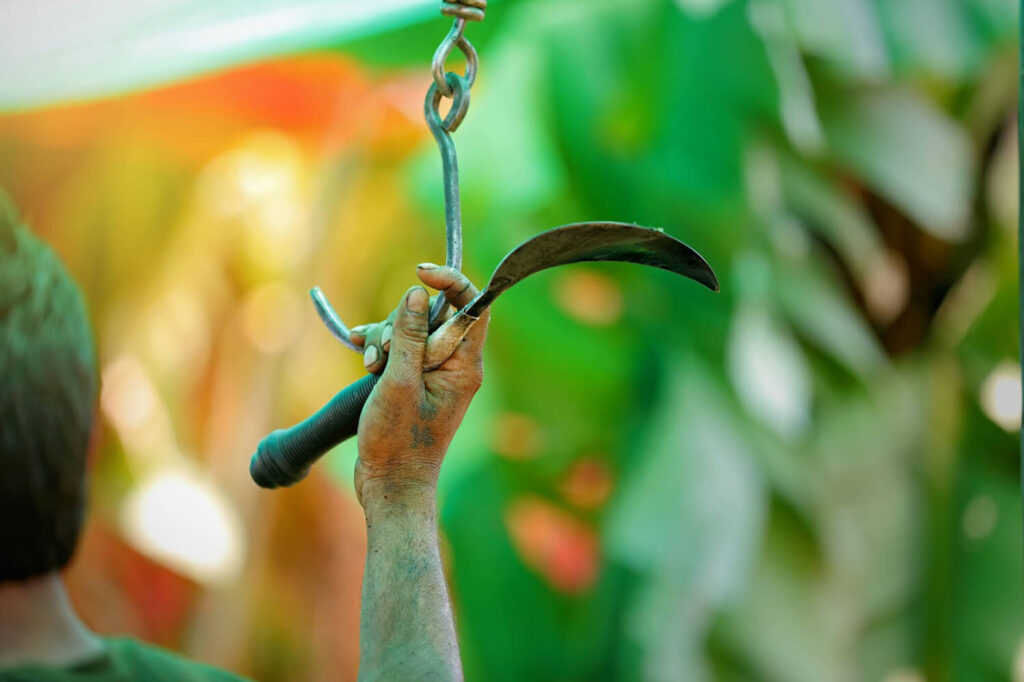
Can’t remove your bonsai from the pot? Instead of breaking the pot, use a sickle saw to release your tree from it.
There are a few possible reasons why you can’t easily remove your tree from the pot. Either the soil is too clumpy or your tree has developed roots into the inner walls of the pot.
Regardless, using a sickle saw or knife will help resolve the problem easily.
Also, you can use the inner side of the blades to trim roots and remove a clump of old soil from the root ball.
How to use a sickle saw to release a bonsai from a pot:
- Stick the sickle saw to one corner of the pot. Make sure that the tip touches the bottom of the pot.
- Next, move along the inner walls of the pot by pulling the sickle saw towards you. (Emphasizing the “pull” motion as the blade teeth are pointed backward).
- Then, use the tip of the sickle saw to lift the clump of soil out of the pot.
Alternative tool to use: Any similar sharp knife.
1 Power Bonsai Tool for Professionals
After years of growing bonsai trees, you would reach a point where you’d want to make things more convenient and efficient—that’s where the use of power tools comes in.
If you want an easier and quicker process of making a shari, here’s one of the most important bonsai tools you’d need:
1. Rotary tool
Category: Styling tool
Some uses:
- To make a shari
- To create hollows
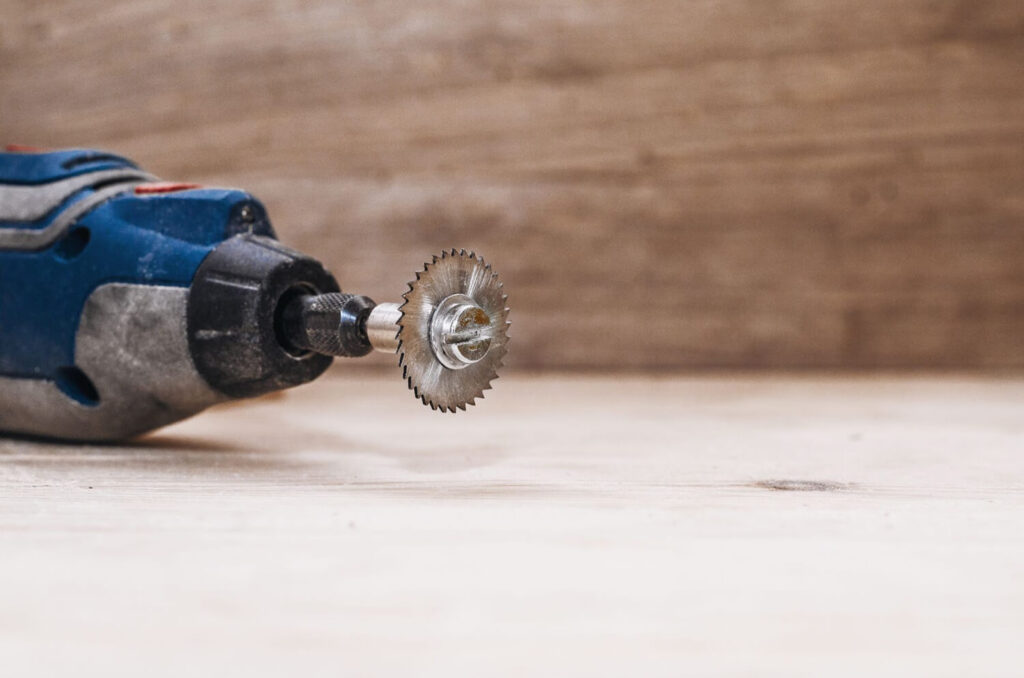
A rotary tool is a heavy-duty and (often) electric tool used for many purposes including grinding and sanding various materials. In the case of bonsai trees, it’s used for creating a shari.
There are two popular and well-trusted brands of rotary tools that professionals use, which are Dremel and Makita. While both perform great, Dremel is slightly more preferred. Since it’s lighter and more compact than Makita power tools.
How to use a rotary tool to create a shari:
- Use a regular marker to outline your desired shari shape.
- Prepare the rotary tool with an installed sandpaper head.
- Position it sidewards (edge of the head touching the wood).
- Then, use it to mark and cut the outline of the shari.
- Next, position it in front of the shari. With the edge of the head still touching the tree.
- Then, glide it downwards several times to create a shari.
- Make a few more runs to smoothen the surface and edges, if necessary.
Tips & reminders:
- Use protective gloves and goggles to prevent any harm.
- Buy a rotary tool with a speed dial, so you can control its strength.
- Use your free hand to support the bottom of the tool. Doing this helps stabilize the tool, which results in cleaner and more precise work.
Carbon Steel vs. Stainless Steel: Which Type of Material to Choose for Your Bonsai Trees?
Most bonsai pruning tools are made of carbon and stainless steel. While both types of tools perform great, they have several differences that set them apart.
To know whether carbon steel tools are better than stainless steel tools, read below:
Carbon steel bonsai pruning tools
Key features: Stronger, cheaper, and holds a sharp blade longer.
Carbon steel materials are known for their high tensile strength and durability, thanks to their carbon content.
That’s why if you want a set of bonsai gardening equipment that holds a sharp blade longer and lasts a lifetime, invest in carbon steel-made tools. This won’t break the bank as tools made of this material are cheaper.
However, the downside of carbon steel is that it’s prone to rust, so it requires higher and more frequent maintenance to prevent corrosion.
Stainless steel bonsai gardening equipment
Key features: Rust-resistant, low maintenance, and has good aesthetic appeal.
Stainless steel materials are popular for their shiny appearance and aesthetic appeal. More than that, it’s highly prized for its rust-resistant trait, thanks to its high percentage of chromium content.
The only downside with stainless steel is that it’s pricey. So, it may not be best for individuals who are still honing their pruning and trimming skills.
There are many bonsai tools used for bonsai growing, each of which has specific uses.
If you want to familiarize yourself with all of it, below is the complete list of bonsai tree tools and their uses. This list also includes several other essential supplies that help make growing and maintaining bonsai trees much easier.
List and Definition of Bonsai Tools and Supplies
A – E
Aluminum training wire: A styling tool. It comes in various gauges and is used to style & hold branches in place. It’s often applied on deciduous and broadleaf evergreen trees at a 45° to 50° angle to avoid branch breakage.
Azalea shears: A pruning tool. Also called Satsuki shears. A small shear used for pruning smaller twigs and branches similar to Azalea’s, hence the name. These can also be used for finer pruning and finishing.
Branch bender: A styling tool. Also called a branch jack or branch clamp. A device used to heavily bend thick or hard branches and trunks into a certain position.
Bud & twig trimming shears: A pruning tool. Also called koeda shears. A pair of slender shears slightly larger than Azalea shears. Its long reach allows easy pruning of hard-to-reach areas, needle buds, and shohin-size bonsai.
Carving tools: A styling tool. Also called grafting tools. A set of hand tools used for creating and detailing jins and shari on some bonsai trees, like junipers, and for cleaning and polishing cut wounds.
Coir brush: A cleaning tool. A handy, brownish brush made of coco fibers for cleaning up a bonsai tree’s soil surface, especially after pruning and styling.
Concave branch cutter: A styling tool. A branch-cutting device specially designed to leave quick-healing concave wounds on the trunk or main branch and also for scoring and tapering jins.
Copper training wire: A styling tool. A wire that also comes with various gauges and is twice as strong as aluminum training wire, making it ideal for wiring coniferous and needled evergreen species at a 60° to 65° angle.
Cut paste: A polishing tool. A type of wound sealant used for bonsai trees that stops the sap from flowing and helps wounds heal faster.
Bonsai training wires double-wrapped around the tree branches.
F – J
Gas torch: A polishing tool. A device used for burning off strands of fibers left on newly-created jins and shari, making them look more neat and polished.
Jin splitter: A styling tool. Also called jin pliers. A specialist tool, similar to regular needle-nose pliers, for creating jins and also for holding and bending training wires.
K – O
Knob cutter: A styling tool. A device that works similarly to a concave branch cutter. The only difference is that it has more rounded edges, leaving deeper, hollow wounds that heal fast and clean.
Leaf trimmer: A pruning tool. A small hand tool for cutting leaves when defoliating bonsai trees.
Lime sulfur: A polishing tool. A chemical used to whiten and protect exposed deadwood (jins and shari) from infection. It leaves a yellowish tint at first and then whitens as the chemical dries.
Needle-nose pliers: A styling support tool. A regular tool for holding wires and creating jins when styling bonsai.
The different uses of various bonsai cutting tools.
P – R
Potting mesh screen: A repotting support tool. Also called a mesh net. A device placed over the pot’s drainage holes to prevent the soil underneath from washing away when watering bonsai. It’s also often wired into place using a bonsai training wire.
Pruning saw: A cutting tool. A hand-sized saw used to remove large, thick branches that concave branch cutters and knob cutters can’t cut.
Pruning shears: A pruning tool. A cutting tool, comparably heavier and bulkier than standard shears, for pruning bonsai tree foliage of most species.
Raffia strips: A styling support tool. It’s soaked and wrapped around branches to prevent brittle parts from breaking or splitting during heavy bending. It can also be applied to protect the bark from scarring due to tight wiring.
Root hook: A repotting tool. A single-prong tool with a rounded edge for loosening and removing soil from the root ball during repotting. Also, for detangling roots before root pruning.
Root cutter: A cutting tool. Also called root pliers. A device that looks similar to a knob cutter. It’s used to prune roots cleanly and with less damage.
Root rake: A repotting tool. A device with three prongs used to remove soil from the root ball during repotting, similar to a root hook.
Rotary tool: A styling tool. A power tool that has a round blade with teeth. It’s used to create natural-looking shari along the bonsai tree trunk.
S – Z
Sickle knife: A repotting tool. A hand tool that looks like a hook-shaped knife. It’s used for removing pot-bound bonsai trees from the pot.
Sickle saw: A repotting tool. A tool that functions similar to a sickle knife, except that its blade has teeth. It’s also used to remove pot-bound trees by cutting the tree roots along the pot’s walls.
Soil sieve: A repotting support tool. Also called a soil sifter. A sifting device used to remove fine dust and other small debris on bonsai soil components, such as akadama.
Standard shears: A pruning tool. Also called butterfly shears. A shear with a large handle and a wide spread angle for trimming leaves, buds, twigs, and even fine roots.
Trunk splitter: A styling tool. A device, similar to a knob cutter but with straight and larger edges, for splitting trunks and larger branches vertically to make them more flexible for bending.
Wire cutter: A cutting tool. It has a round edge that helps prevent bite marks when cutting wires close to the tree. It also has a long handle, making it easier to reach deeper areas.
Wooden chopsticks: A repotting and watering support tool. It can be used like a root hook or rake to remove old soil from the root ball and as a moisture meter between watering.
Name of some of the most common bonsai tree tools (from left to right):
- Wire cutter
- Jin splitter
- Root cutter
- Knob cutter
- Butterfly shears
- Concave branch cutter
- Root rake
- Root hook
- Leaf trimmer
- Branch bender
- Long-handle standard shears
- Bud and twig trimming shears
- Trunk splitter
To properly and skillfully grow a bonsai tree, you’d have to perform various bonsai techniques. For that, you’d need tools and supplies specifically made for bonsai art.
Conclusion
There are many tools needed to perform specific bonsai techniques, but you don’t necessarily need to have all of them.
For beginners, you’d only need at least a wooden chopstick, a pair of pruning shears, a concave branch cutter, and a wire cutter as your primary bonsai tools. Once you’ve gained more experience and skills, you can start investing in specialty bonsai pruning tools such as a jin splitter or even a rotary tool.
The goal is to keep your bonsai tree alive and thriving!





0 Comments